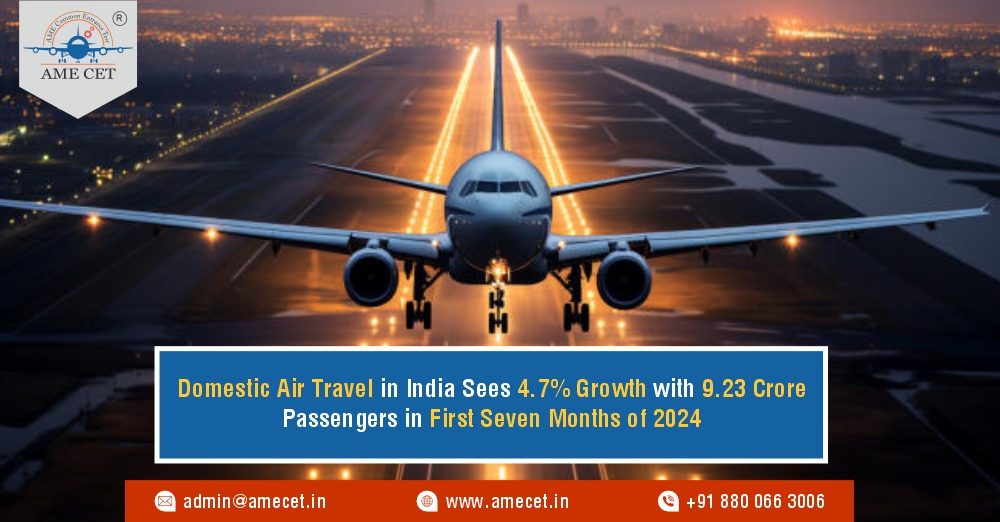
In a promising sign for India’s aviation sector, the latest traffic data reveals a notable increase in domestic air travel. From January to July 2024, Indian domestic airlines carried a total of 9.23 crore passengers, marking a 4.7% rise compared to the 8.82 crore passengers during the same period in 2023. This growth underscores a robust recovery and expansion in the aviation industry, reflecting increased consumer confidence and economic activity.
Positive Trajectory for Indian Aviation
The 4.7% increase in passenger traffic is a significant indicator of the sector’s resilience and growth potential. The surge in air travel demand can be attributed to several factors, including the gradual recovery from the COVID-19 pandemic, improved economic conditions, and enhanced connectivity between tier-2 and tier-3 cities.
Industry experts have noted that the growth trajectory aligns with broader economic trends in India. As the country continues to recover from the pandemic’s economic impacts, consumer spending has increased, leading to higher demand for travel. Additionally, the expansion of low-cost carriers and competitive pricing strategies have made air travel more accessible to a larger segment of the population.
Economic Impact and Job Opportunities
The growth in domestic air travel is not just a boon for airlines but also has significant implications for the broader economy. The aviation sector's expansion creates a ripple effect across various industries, including hospitality, tourism, and retail, all of which benefit from increased passenger numbers.
Increased passenger traffic translates into greater demand for services and infrastructure, leading to job creation and economic development. The aviation sector alone has seen a boost in employment opportunities across various domains, including:
-
Airline Operations: The rise in passenger numbers necessitates additional staffing in airlines, including pilots, cabin crew, and ground staff. Airlines are hiring more personnel to manage the increased volume of flights and ensure operational efficiency.
-
Airport Services: Airports are experiencing higher foot traffic, leading to an increase in job opportunities in areas such as security, baggage handling, customer service, and maintenance. The expansion of airport infrastructure also creates construction and engineering jobs.
-
Hospitality and Tourism: With more passengers traveling domestically, the hospitality sector, including hotels, restaurants, and tour operators, is seeing a surge in business. This, in turn, generates employment opportunities in these sectors.
-
Transportation and Logistics: Increased air travel often leads to higher demand for ground transportation services, including taxis, car rentals, and shuttle services. This growth benefits the logistics and transportation sectors, creating additional job opportunities.
Challenges and Future Outlook
While the increase in domestic air travel is a positive development, it also presents challenges. Airlines and airports must address issues such as congestion, infrastructure limitations, and environmental concerns. Ensuring the sustainability of growth while maintaining service quality and safety standards is crucial.
Looking ahead, the future of domestic air travel in India appears promising. The government's focus on enhancing aviation infrastructure, including the development of new airports and the expansion of existing ones, is expected to support continued growth. Additionally, initiatives such as the UDAN (Ude Desh ka Aam Nagrik) scheme aim to improve connectivity to underserved regions, further boosting passenger traffic.
Conclusion
The 4.7% increase in domestic air travel in India during the first seven months of 2024 is a testament to the sector’s recovery and growth. This positive trend not only highlights the resilience of the aviation industry but also underscores its role in driving economic development and job creation. As the sector continues to expand, it is likely to contribute significantly to India’s economic growth, offering new opportunities and challenges for stakeholders across the industry
Category
-
Aircraft Maintenance Engineering (DGCA) (55)
-
Cabin Crew (1)
-
Aircraft Maintenance Engineer (AME) (1)
-
Aerospace Engineering (3)
-
Commercial Pilot License(CPL) (80)
-
(190)
-
Aircraft Maintenance Engineering (BTech/BE) (4)
-
Aeronautical Engineering (2)
-
Airport Management (5)
-
Aircraft Maintenance Engineering (EASA) (11)
-
Airport Ground Staff (1)
-
B.Sc. in Aviation (1)
-
AME CET (5)
